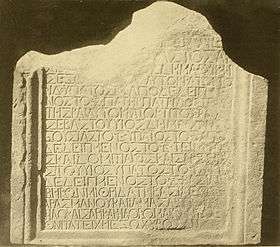Pharasmanes I of Iberia
| Pharasmanes I | |
|---|---|
 Pharasmanes I is mentioned on Armazi stele of Vespasian | |
| King of Iberia | |
| Reign | 1 – 58 |
| Predecessor | Arshak II of Iberia |
| Successor | Mihrdat I of Iberia |
| Born |
1st-century BC Mtskheta, Kingdom of Iberia |
| Died | 58 AD |
| Spouse | daughter of Tigranes IV |
| Issue |
Mihrdat I of Iberia Rhadamistus Amazaspus |
| Dynasty | Pharnavazid dynasty |
| Father | Kartam of Colchis |
| Mother | daughter of Pharnavaz II of Iberia |
Pharasmanes I (Georgian: ფარსმან I) (died 58) was a king of Iberia. He plays a prominent role in the historian Tacitus’ account of policy and campaigns in the eastern Roman Empire under Tiberius, Claudius and Nero. According to Cyril Toumanoff, Pharasmanes was a member of the third Pharnavazid dynasty and reigned from 1 to 58.
Life
As allies of Rome, his brother Mithridates was installed as king of Armenia by Roman emperor Tiberius, who invaded Armenia in 35. When the Parthian prince Orodes, son of Artabanus III of Parthia, attempted to dispossess Mithridates of his newly acquired kingdom, Mithridates led a large Armenian and Iberian army and defeated the Parthians in a pitched battle (Tacitus, Annals. vi. 32-35).[1]
At an unknown date, Pharasmanes married an unnamed Armenian princess of the Artaxiad dynasty. She was the daughter of the Artaxiad Armenian monarchs Tigranes IV and his sister-wife Erato. His Armenian wife bore him three sons: Mithridates I (Mihrdat), Rhadamistus, and Amazaspus (Amazasp), who is known from the Epigram of Amazaspos found in Rome.
Around 52, Pharasmanes instigated Rhadamistus, whose ambitious and aspiring character began to give him umbrage, to make war upon his uncle Mithridates, and supported him in his enterprise. After a short reign, Rhadamistus was in turn expelled by the Parthians in 55, and took refuge again in his father's dominions. The Romans had expressed their displeasure at the proceedings of Rhadamistus, and in order to curry their favor, Pharasmanes put his son to death.[2] Pharasmanes was apparently succeeded by Mithridates (Mihrdat) I.[3]
Toumanoff has tentatively suggested the identification of Pharasmanes with the Aderki (or Rok) of the medieval Georgian chronicles whose reign is said to have coincided with the appearance of the first Christian communities in Iberia, and the travel of the Jews from Mtskheta to Jerusalem whence they witnessed the crucifixion of Jesus and brought the Holy Tunic to Iberia. According to the Georgian chronicles, Aderki’s division of his kingdom between his two sons, Kartam (Kardzam) and Bartom (Bratman), inaugurated the start of dyarchy in Iberia which would last for five generations. Many modern scholars, however, doubt the existence of the diarchy, for the contemporary foreign source make references only to sole monarch.[4]
See also
References
- ↑ Grousset, History of Armenia from its origins to 1071, p.89, 106
- ↑ Tacitus, Annales xii. 42-48, xiii. 6, 37.
- ↑ Toumanoff, Cyril (1967). Studies in Christian Caucasian History, p. 101. Georgetown University Press.
- ↑ Rapp, Stephen H. (2003), Studies In Medieval Georgian Historiography: Early Texts And Eurasian Contexts, pp. 285-287. Peeters Publishers, ISBN 90-429-1318-5.
![]() This article incorporates text from a publication now in the public domain: Smith, William, ed. (1870). "article name needed". Dictionary of Greek and Roman Antiquities. London: John Murray.
This article incorporates text from a publication now in the public domain: Smith, William, ed. (1870). "article name needed". Dictionary of Greek and Roman Antiquities. London: John Murray.
| Preceded by Artaxias II |
King of Iberia c. 1 – 58 |
Succeeded by Mithridates I |